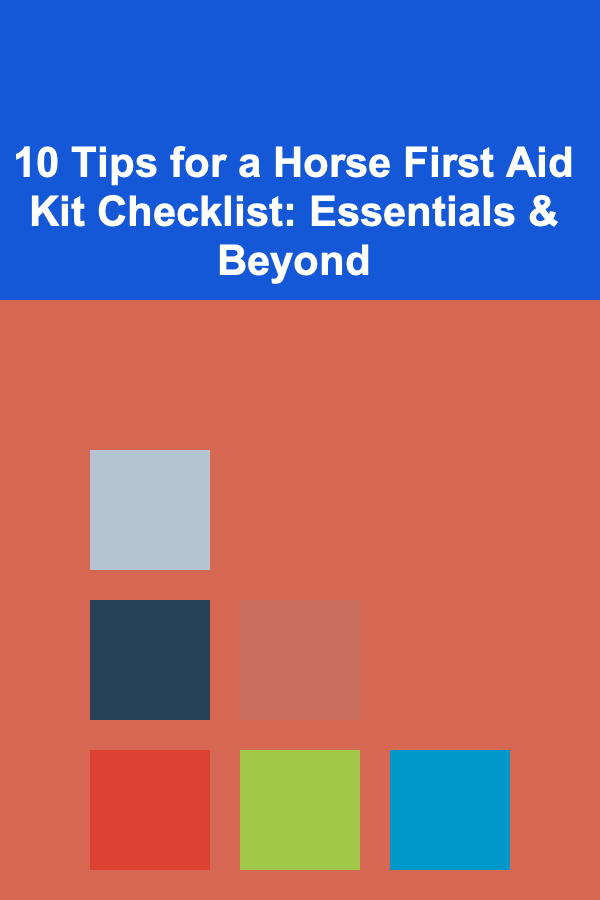
10 Tips for a Horse First Aid Kit Checklist: Essentials & Beyond
ebook include PDF & Audio bundle (Micro Guide)
$12.99$5.99
Limited Time Offer! Order within the next:

As a horse owner, the health and well-being of your horse are paramount. Horses are majestic and strong animals, but they are also vulnerable to injuries and emergencies. Whether you're training, riding, or simply caring for your horse, accidents can happen, and it's important to be prepared. One of the most critical preparations you can make is having a well-stocked and organized first aid kit on hand. A properly equipped horse first aid kit can help you address minor injuries, treat common ailments, and potentially save your horse's life in the event of an emergency.
In this comprehensive guide, we'll walk you through 10 essential tips for creating a horse first aid kit checklist, providing both must-have supplies and some advanced items for more specific needs. Let's dive into the key components every horse owner should include in their first aid kit.
Start with the Basics: Bandages and Dressings
Bandages and dressings are fundamental to any horse first aid kit. They are used to control bleeding, protect wounds, support sprains, and provide compression for swelling. It's important to have a variety of bandages, each suited for different types of injuries.
Essential Items:
- Adhesive bandages (for small cuts or abrasions)
- Gauze pads and rolls (for larger wounds or absorbing fluids)
- Vet wrap (self-adhesive bandage) (for securing dressings or holding splints)
- Padded bandages (for leg injuries or to provide extra cushioning)
- Cotton wool (for padding and absorbing fluids)
Tip: When using bandages, avoid wrapping them too tightly, as this can impair circulation. Always monitor the injured area for swelling or signs of circulation problems.
Antiseptics and Disinfectants for Wound Care
Wound care is crucial to prevent infection, especially in a horse that spends a lot of time outdoors. Antiseptics and disinfectants are essential for cleaning wounds before applying dressings.
Essential Items:
- Antiseptic solution (like iodine or chlorhexidine)
- Betadine or hydrogen peroxide (for cleaning wounds)
- Rubbing alcohol (for cleaning skin around the wound or disinfecting equipment)
- Antibiotic ointment (such as Neosporin) for topical application after cleaning
Tip: While hydrogen peroxide is effective for cleaning wounds, it can delay healing if overused. Consider using milder solutions like saline for more frequent cleaning.
Pain Relief and Anti-Inflammatory Medications
Horses can suffer from various conditions that cause pain or inflammation, such as sprains, strains, or joint issues. Having pain relief medications on hand can help alleviate discomfort until you can seek professional care.
Essential Items:
- NSAIDs (Non-Steroidal Anti-Inflammatory Drugs) : Common medications include Bute (phenylbutazone) or Banamine (flunixin meglumine).
- Topical pain relief: Creams or gels for muscle soreness or joint pain.
Tip: Always follow the correct dosage instructions provided by your veterinarian when administering pain medications. Overuse can have serious side effects, particularly with NSAIDs.
Thermometers for Temperature Monitoring
A temperature check is one of the easiest ways to assess the health of your horse. Monitoring your horse's temperature can provide important early signs of illness, infections, or inflammation.
Essential Items:
- Digital thermometer: Choose a flexible, waterproof one for easier use.
- Disposable probe covers: For hygiene purposes when taking the temperature.
Tip: A normal horse temperature ranges from 99°F to 101°F (37.2°C to 38.3°C). If your horse's temperature exceeds 101.5°F (38.6°C), it may be a sign of infection, and you should consult a veterinarian.
Hoof Care Tools
The hooves are among the most important parts of your horse's body, and hoof injuries are not uncommon. A good first aid kit should include basic tools for handling hoof issues and minor injuries.
Essential Items:
- Hoof pick: Used to clean debris and dirt from hooves, which can cause infections.
- Hoof poultice: For treating abscesses or infections.
- Hoof bandages: Used for wrapping and protecting hoof injuries.
- Hoof dressings: To promote healing of cracks or injuries.
Tip: Always clean and check your horse's hooves regularly. Preventative care is just as important as emergency treatments.
Sutures and Wound Closure Supplies
In the event of deep or large cuts, your horse may require stitches or other forms of wound closure. While this is something a veterinarian should ideally handle, it's important to have the supplies on hand for emergencies.
Essential Items:
- Sterile sutures or wound closure strips: If you're trained in basic wound care, you can use these for emergency closure of minor deep wounds.
- Suture removal kit: In case you need to remove stitches under veterinary guidance.
Tip: For deep or large wounds, always contact your veterinarian. Improper closure can lead to infection, scarring, or improper healing.
Splints and Supports for Injuries
Horses can suffer from leg injuries like sprains, strains, or fractures, and it's essential to stabilize the injury before professional help arrives. Splints and supports can help immobilize a limb to prevent further damage.
Essential Items:
- Lightweight splints: These should be flexible enough to provide support but not restrict blood flow.
- Elastic bandages: For securing the splint in place.
- Leg wraps: To provide additional support or reduce swelling.
Tip: Use soft, padded materials to prevent further damage to the horse's leg when applying a splint or bandage.
Eye Care Products
Horses are prone to eye injuries, whether from dirt, debris, or accidents. It's essential to be prepared to care for your horse's eyes in an emergency.
Essential Items:
- Eye wash or saline solution: To flush debris or irritants from the eye.
- Eye ointments or gels: To treat minor irritations or infections.
- Protective eye cover: For use in the event of a serious injury or to prevent further damage to the eye.
Tip: Never try to remove an object embedded in the eye. Always contact your veterinarian, as improper handling can cause more harm.
First Aid Manual or Emergency Guide
In an emergency, having a quick reference guide can make all the difference. A first aid manual or emergency guide can help you stay calm and guide you through the steps needed to treat your horse.
Essential Items:
- Emergency contact numbers: Include the number of your regular vet, an emergency clinic, and any relevant specialists.
- A printed or digital first aid guide: A quick reference for symptoms, treatment options, and when to seek veterinary help.
- A list of any medications your horse is on, including dosages and instructions.
Tip: Familiarize yourself with the contents of your first aid kit and practice handling emergencies, so you feel confident when real situations arise.
Hydration and Electrolytes
In cases of illness, heat stress, or intense physical exertion, a horse may become dehydrated. It's important to have supplies on hand to help rehydrate your horse and restore essential electrolytes.
Essential Items:
- Electrolyte powder or solution: Can be added to water to help replenish lost electrolytes.
- Syringe or dosing syringe: For administering electrolytes or fluids if your horse refuses to drink.
- Water: Always have clean, fresh water available for hydration.
Tip: Make sure your horse always has access to clean, fresh water, especially during intense training, competition, or on hot days.
Beyond the Essentials: Other Useful Items
While the 10 items above form the backbone of any horse first aid kit, there are a few additional items that could be useful in specific situations:
- Ear thermometer: For more precise temperature readings.
- Scissors: For cutting bandages, vet wrap, or other materials.
- Tweezers: To remove splinters or small foreign objects.
- Cold packs: To reduce swelling and provide immediate relief for strains or injuries.
- Flashlight: For low-light conditions, especially when dealing with night-time injuries.
Final Thoughts: Be Prepared, Stay Calm, and Act Fast
Creating a well-stocked horse first aid kit is just the first step in ensuring your horse's safety and health. The key to handling emergencies effectively is being prepared. Regularly check and update your first aid kit to ensure that all items are in good condition, that medicines haven't expired, and that you have the latest contact information for your vet.
By following these 10 tips, you'll be equipped to handle common horse injuries, illnesses, and emergencies. However, it's important to remember that while having the right supplies is crucial, your knowledge and ability to stay calm in stressful situations are just as important. Whenever in doubt, consult a veterinarian---quick action can make all the difference in your horse's recovery.
In addition to maintaining your first aid kit, consider taking a first aid or emergency care course to sharpen your skills. The more you know, the better prepared you will be to care for your horse when emergencies arise.
Reading More From Our Other Websites
- [Home Renovating 101] How to Refinish Wood Floors for a Fresh Look Without Replacing Them
- [Home Lighting 101] How to Use Patio Lighting to Create Different Moods and Ambiance for Outdoor Gatherings
- [Home Staging 101] How to Stage Your Home's Dining Area for Family Gatherings
- [Home Cleaning 101] How to Maintain a Minimalist Home Cleaning Routine
- [Home Space Saving 101] How to Organize Your Jewelry Collection in Small Spaces
- [Home Space Saving 101] How to Use Folding Furniture to Save Space
- [Personal Care Tips 101] How to Choose a Body Spray for a Tropical or Exotic Feel
- [Home Pet Care 101] How to Use Pet Obesity Facts to Start a Home Weight Loss Journey for Your Beloved Companion
- [Home Storage Solution 101] How to Master Basket Storage Ideas for Every Room: A Guide to Stylish Organization
- [Organization Tip 101] How to Prioritize Home Maintenance Tasks with a Checklist

How to Build a Profitable Membership Site
Read More
How to Create a Website Maintenance Checklist for Beginners
Read More
How to Evaluate and Reduce Subscription Services
Read More
How to Save Money on Drinks While Traveling
Read More
How to Avoid Credit Card Fees
Read More
10 Tips for Integrating Your Knitting Planner with Ravelry
Read MoreOther Products

How to Build a Profitable Membership Site
Read More
How to Create a Website Maintenance Checklist for Beginners
Read More
How to Evaluate and Reduce Subscription Services
Read More
How to Save Money on Drinks While Traveling
Read More
How to Avoid Credit Card Fees
Read More